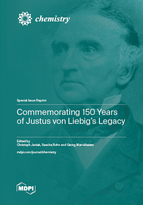Commemorating 150 Years of Justus von Liebig’s Legacy
A special issue of Chemistry (ISSN 2624-8549).
Deadline for manuscript submissions: closed (31 May 2023) | Viewed by 34690
Special Issue Editors
Interests: metal-organic frameworks; nanoparticles; catalysis; coordination polymers
Interests: food proteins; secondary plant metabolites; compound stability and interactions
Special Issues, Collections and Topics in MDPI journals
Interests: organic synthesis; synthetic methodology; stereoselecticve synthesis; sustainable synthesis; multicomponent reactions; fixation of sulfur dioxide into small organic molecules
Special Issues, Collections and Topics in MDPI journals
Special Issue Information
Dear Colleagues,
Justus Freiherr von Liebig (1803–1873) was one of the great German chemists of the 19th Century CE, and it is our privilege to honour his achievements and legacy on the occasion of the sesquicentennial of his death. Although he is primarily remembered today as an organic chemist, his contributions covered numerous aspects of organic, inorganic, applied, and technical chemistry, and we hope to do justice to his multiple facets in this Special Issue.
From the earliest class in the chemistry practical laboratory, today’s students encounter the ubiquitous Liebig’s condensor, the classical counter-current water-cooled condensor used for reactions under reflux or for distillations. Liebig often worked at the interface of organic and inorganic chemistry, exemplified by his work on silver fulminate, an isomer of the silver cyanate prepared by Wöhler.
Liebig was one of the pioneers in systematic organic chemistry, being prominent in the development of the theory of radicals and being a master of the art of transformation and degradation of organic materials. His output in his most creative years is prodigious.
In addition to his research, Liebig was a scientist in the von Humboldt tradition and made enormous contributions to the teaching of both theoretical and practical chemistry.
Less well known to the chemical audience are his exceptional contributions to plant and animal physiology and nutrition. Once again, these had a basis in the fundamental chemistry of life and bridged classical organic and inorganic chemistry.
Liebig had wide-ranging interests in food technology and nutrition and was particularly involved in the technology of preparing meat and vegetable extracts, some of which are well known to Anglophile audiences even today. His methods for producing beef extracts resulted in the establishment of Liebig’s Extract of Meat Company, which is the linear antecedent of the UK product «Oxo». Similarly, his process for the manufacture of yeast extracts can be seen as the progenitor of the UK savoury spread «Marmite».
We welcome contributions commemorating all aspects of Liebig’s life and work.
Prof. Dr. Christoph Janiak
Prof. Dr. Sascha Rohn
Prof. Dr. Georg Manolikakes
Guest Editors
Manuscript Submission Information
Manuscripts should be submitted online at www.mdpi.com by registering and logging in to this website. Once you are registered, click here to go to the submission form. Manuscripts can be submitted until the deadline. All submissions that pass pre-check are peer-reviewed. Accepted papers will be published continuously in the journal (as soon as accepted) and will be listed together on the special issue website. Research articles, review articles as well as short communications are invited. For planned papers, a title and short abstract (about 100 words) can be sent to the Editorial Office for announcement on this website.
Submitted manuscripts should not have been published previously, nor be under consideration for publication elsewhere (except conference proceedings papers). All manuscripts are thoroughly refereed through a single-blind peer-review process. A guide for authors and other relevant information for submission of manuscripts is available on the Instructions for Authors page. Chemistry is an international peer-reviewed open access quarterly journal published by MDPI.
Please visit the Instructions for Authors page before submitting a manuscript. Submitted papers should be well formatted and use good English. Authors may use MDPI's English editing service prior to publication or during author revisions.








